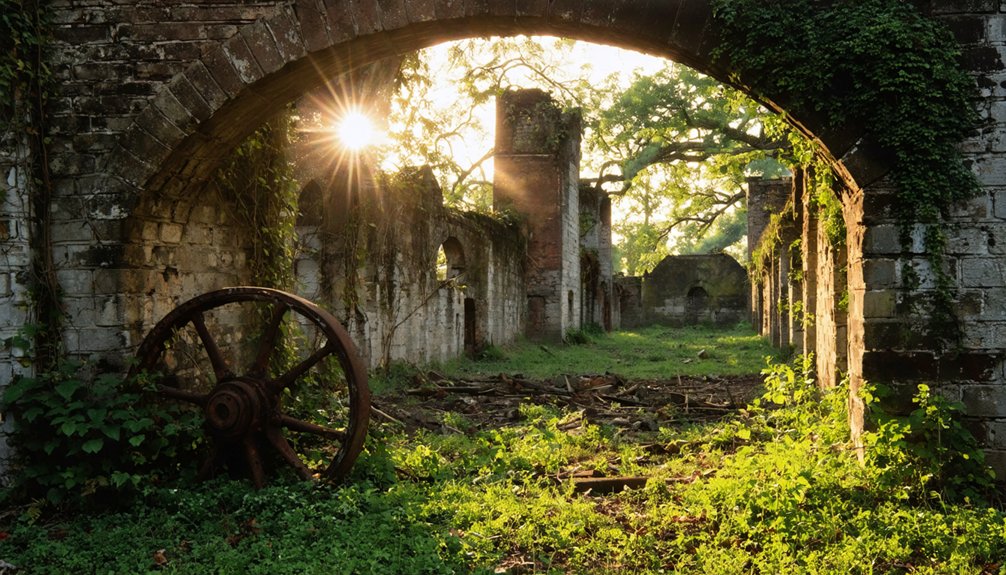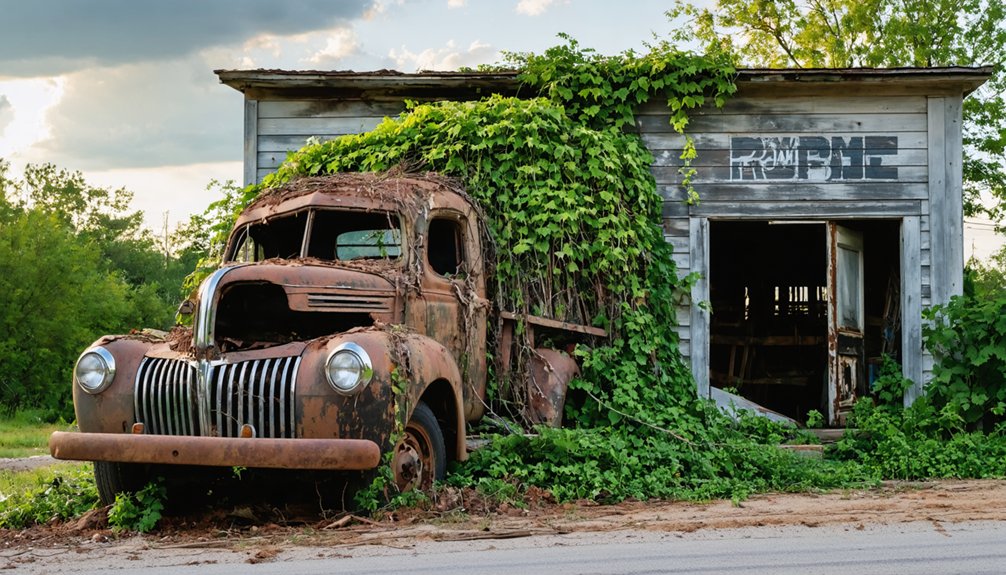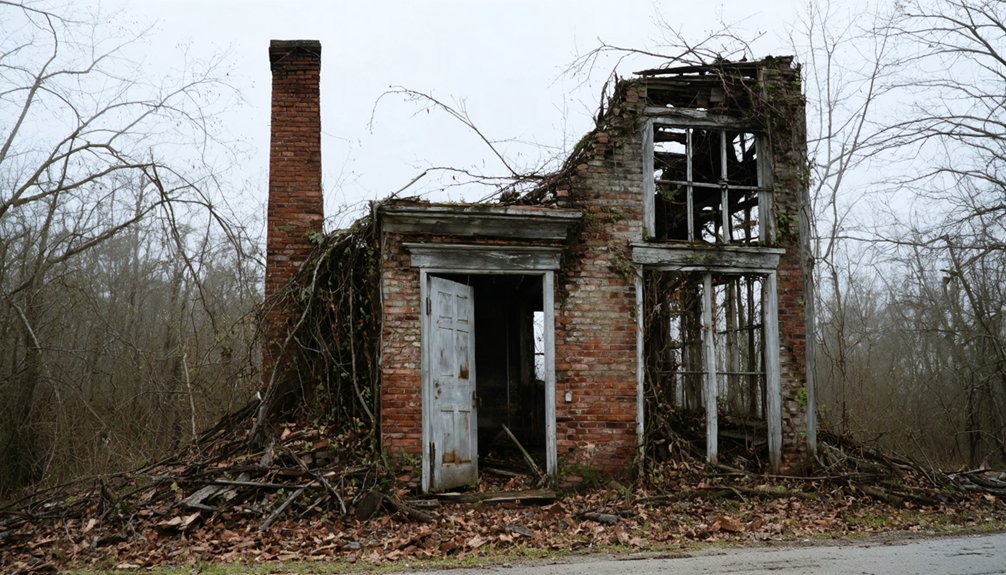You’ll discover Louina’s fascinating remains along the eastern bank of Alabama’s Tallapoosa River, where this frontier trading post thrived from 1834 until the early 1900s. Founded by Isham Weathers and named after a wealthy Creek trader, the town grew to include thirty homes, two churches, and multiple businesses. While the Atlanta, Birmingham, and Atlantic Railroad’s bypass in 1906 led to Louina’s decline, the site’s rich archaeological treasures hold countless untold stories.
Key Takeaways
- Louina was established in 1834 along the Tallapoosa River and grew into Randolph County’s largest town before becoming a ghost town.
- The town featured thirty homes, two churches, multiple stores, a gristmill, wool factory, and cotton gin during its peak.
- Named after a wealthy Creek trader, Louina was a vital connection point between Native Americans and settlers after the 1814 Creek defeat.
- The town’s decline began when the Atlanta, Birmingham, and Atlantic Railroad bypassed it in 1906, favoring nearby Wadley instead.
- Today, Louina exists only as an archaeological site, preserving remnants of its historic structures and cultural heritage.
The Birth of a Frontier Trading Post
In 1834, Isham Weathers established a pivotal trading post on the eastern bank of the Tallapoosa River, marking the birth of Louina, Alabama. The town’s trading post origins can be traced to its namesake, a wealthy Native American woman named Louina, who’d previously operated her own trading station in the area before being forced to relocate.
You’ll find this strategic location, situated just one mile north along the river’s east bank, became essential for early settler interactions and commerce.
After the Creek Indians’ defeat at Horseshoe Bend in 1814, the area opened for American settlement. Weathers’ store served as the primary point of contact between settlers and Native Americans, dealing in frontier necessities and local goods.
This commercial hub quickly attracted other merchants and settlers, transforming Louina into the county’s chief business center. The town grew to include thirty occupied homes, becoming a thriving frontier community. The settlement eventually expanded to include two churches and developed into the largest town in Randolph County.
Economic Powerhouse of Randolph County
Prosperity defined Louina during its economic peak, when the town generated more than one-third of Randolph County’s tax revenue before the Civil War.
Before the Civil War, Louina was an economic powerhouse, contributing over one-third of Randolph County’s entire tax revenue.
You’d have found a bustling commercial center where prosperity factors included multiple stores, a thriving gristmill, wool factory, and cotton gin. The business evolution of this frontier powerhouse was marked by the establishment of the county’s first newspaper, which served as a crucial communication hub before relocating to Wedowee. The last signs of commerce ended when the final store closed in 1902.
As a strategic point along the stagecoach line connecting Wedowee to Dadeville, Louina’s commercial influence extended throughout the region. The town’s origins trace back to when it was named after a Native American trader who owned a local trading post.
The town’s economic strength was further evidenced by its robust civic infrastructure, including a Masonic Lodge, two schools, and several churches, making it the largest and most prosperous settlement in Randolph County.
Daily Life in Antebellum Louina
Life in antebellum Louina revolved around a vibrant mix of religious, educational, and social institutions that shaped the community’s character.
You’d find your children attending gender-separated schools, while the Baptist and Methodist churches served as pillars of community life. The education systems reflected the era’s values, preparing boys and girls for their distinct societal roles. The local county’s first newspaper kept residents informed of community happenings.
Family dynamics centered around thirty households, where you’d likely work as a farmer, merchant, or craftsperson.
Your social calendar would include Masonic Lodge meetings, church services, and gatherings at local taverns. You’d conduct business at one of eight stores, process your crops at the gristmill, or ship goods via the stage line.
The ferry crossing kept you connected to neighboring communities, while the post office linked you to the wider world.
Native American Heritage and Cultural Roots
Before becoming a bustling antebellum settlement, Louina traced its roots to a wealthy Creek trader who operated a thriving trading post along the Tallapoosa River.
The area’s indigenous heritage stretched back millennia, with evidence of Native American habitation dating to 4,000 BCE. You’ll find this cultural legacy preserved in both local stories and historical markers.
The town became Randolph County’s chief business center in the years following its establishment in 1834.
The region’s Native American connections remain evident through:
- The major Creek village of Wiwa’towa near present-day Wedowee
- The legend of Louina’s buried silver, symbolizing the wealth and economic sophistication of Creek society
- The trading post’s location along traditional Native American routes, highlighting its strategic importance
The forced removal of the Creek Nation in 1832 opened the land for Euro-American settlement, forever changing the area’s cultural landscape.
The Railroad’s Impact and Town’s Decline
While Louina once thrived as a bustling commercial center, its fate changed dramatically when the Atlanta, Birmingham, and Atlantic Railroad bypassed the town in 1906.
Instead of crossing through Louina, the railroad tracks were laid on the opposite bank of the Tallapoosa River, a decision that would prove devastating for the town’s future.
The railroad’s impact sparked the rise of a new settlement called Wadley on the other side of the river, where merchants and residents gradually shifted their business interests.
As the railroad transformed the landscape, Wadley emerged and flourished while drawing commerce away from its aging rival across the river.
You can trace Louina’s town decline directly to this critical transportation development – without direct rail access, the once-prosperous community couldn’t compete with newer, rail-connected towns.
The railroad fundamentally redirected the region’s economic lifeblood away from Louina, sealing its eventual transformation into a ghost town.
Archaeological Treasures and Local Legends
Today, Louina’s abandoned location on the Tallapoosa River’s east bank serves as a rich archaeological site, drawing researchers and students enthusiastic to uncover its 19th-century remains.
You’ll find foundations of historic structures scattered across the landscape, telling tales of a once-thriving community.
The site’s most intriguing aspect centers around the legendary Native American woman who gave Louina its name.
Folklore enthusiasts continue searching for her fabled buried treasure, which she allegedly couldn’t transport when forced to leave.
While exploring the area, you’ll discover:
- Remnants of two churches, schools, and a Masonic Lodge
- Foundations of the original trading post, gristmill, and wool factory
- Archaeological evidence of Creek Indian and settler interactions
These physical remnants provide tangible connections to Louina’s rich cultural heritage.
Frequently Asked Questions
Are There Any Remaining Structures or Ruins Visible at Louina Today?
Like whispers of the past, you’ll find scattered cemetery headstones and remaining foundations hidden beneath nature’s veil, though no intact buildings stand at this historically significant site.
What Happened to the Residents After They Left Louina?
You’ll find most residents moved to railroad towns like Wadley and Viola, though historical research can’t trace everyone’s path. Ghost stories suggest some stayed nearby, while others spread throughout the region.
Is the Site Accessible to Public Visitors?
Standing amid silent woods, you’ll find limited public access to this archaeological site. While you can visit the historic marker, there aren’t established visitor guidelines or formal touring facilities.
Has Any Professional Archaeological Excavation Been Conducted at the Site?
You won’t find records of professional archaeological excavations here – only student-led digs and amateur searches have explored the site’s archaeological significance, using basic excavation methods to uncover settlement-era artifacts.
Were There Any Documented Civil War Battles Near Louina?
While 120,000 Alabamians fought in the Civil War, you won’t find any documented battlefields near Louina. The closest major battles were fought at Mobile Bay, over 200 miles to the south.
References
- https://digitalalabama.com/alabama-stories/alabama-treasure-legends/the-lost-treasure-of-louina-alabama/46273
- https://digitalalabama.com/alabama-ghost-towns/louina-alabama-gold-and-silver/5889
- http://stillmagnolias.blogspot.com/2014/08/the-history-of-ghost-town-called-louina.html
- https://randolphcountyal.com/randolph-county/history/
- https://en.wikipedia.org/wiki/Louina
- https://kids.kiddle.co/Louina
- https://sites.rootsweb.com/~alghstwn/randolph.html
- https://www.newspapers.com/article/the-anniston-star-louina-randolph-commun/8410819/?locale=en-US
- https://www.hmdb.org/m.asp?m=92503
- https://randolphcountyal.gov/history-of-our-county-seat/the-randolph-county-poor-farm/



